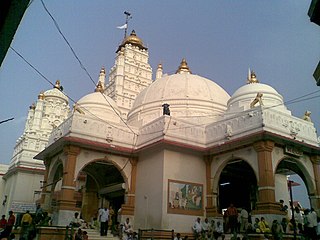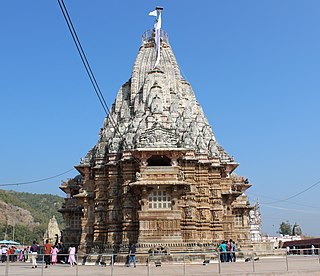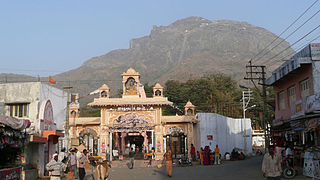Related Research Articles

Dakor is a small city and a municipality in Kheda district in the state of Gujarat, India. It is prominent for its grand temple of Shree Ranchhodraiji.

Shamlaji, also spelled Shamalaji, is a major Hindu pilgrimage centre in Aravalli district of Gujarat state of India. The Shamlaji temple is dedicated to Vishnu. Several other Hindu temples are located nearby.

Mahakaleshwar Jyotirlinga is a Hindu temple dedicated to Shiva and is one of the twelve Jyotirlingams, shrines which are said to be the most sacred abodes of Shiva. It is located in the ancient city of Ujjain in the state of Madhya Pradesh, India. The temple is situated on the side of the holy river Shipra. The presiding deity, Shiva in the lingam form is believed to be Swayambhu, deriving currents of power (Shakti) from within itself as against the other images and lingams that are ritually established and invested with mantra-shakti.
Wai is a town in Satara district of Maharashtra state in India. Located on the Krishna River, Wai was a prominent town during the Peshwa era. Two important Maratha Brahmin from ruling families had their origins here: Rani Lakshmibai of Jhansi and Gopikabai, wife of Nanasaheb Peshwa.
Prabhas Patan, also known as Somnath Patan or Prabhas Ksheta, historically named Dev Patan, is an area situated in Veraval, Gir Somnath district in Saurashtra region of Gujarat, India. Somnath temple, a place of pilgrimage due to its importance as Jyotirlinga site dedicated to Shiva, is located here.

Devprayag is a town and a nagar panchayat (municipality) in Tehri Garhwal District in the state of Uttarakhand, India, and is the final one of the Panch Prayag of Alaknanda River where Alaknanda meets the Bhagirathi river and both rivers thereafter flow on as the Ganges river or Ganga.

Pauri Garhwal is a district in the Indian state of Uttarakhand. Its headquarters is in the town of Pauri. It is sometimes referred to simply as Garhwal district, though it should not be confused with the larger Garhwal region of which it is only a part.

Ganga is the personification of the river Ganges who is worshipped by Hindus as the goddess of purification and forgiveness. Known by many names, Ganga is often depicted as a beautiful fair woman, riding a divine creature called Makara. Some of the earliest mentions of Ganga are found in the Rigveda, where she is mentioned as the holiest of the rivers. Her stories mainly appear in post-Vedic texts such as Ramayana, Mahabharata and the Puranas.
Ranavav is a city and a municipality in Porbandar district in the Indian state of Gujarat.

The Shree Vajreshwari Yogini Devi Mandir is a Hindu temple dedicated to the goddess Vajreshwari, located in the town Vajreshwari, 75 km away from Mumbai. The town, earlier known as Vadvali, was renamed Vajreshwari in honour of the presiding deity of the temple.

The Char Dham is a set of four pilgrimage sites in India. It is believed that visiting these sites helps achieve moksha (salvation). The four Dhams are, Badrinath, Dwarka, Puri and Rameswaram. It is believed that every Hindu should visit the Char Dhams during one's lifetime. The Char Dham as defined by Adi Shankaracharya consists of four Hindu pilgrimage sites. This main 'dhams' are the places of lord Vishnu and Ramashwaram is of lord Shiva. All the 'dhams' are related to four epochs,(1) Dham of Satyug- Badrinath, Uttarakhand (2) Dham of Tretayug -Rameshwaram, Tamil Nadu (3) Dham of Dwaperyug - Dwarika, Gujarat (4) Dham of Kalyug - Jaganath Puri, Odisha.

Bhavnath is a locality in Junagadh city of Gujarat, India. It sits near the Girnar mountain range, close to Girnar Taleti, the place from where pilgrims have to ascend on foot to get to temples on Girnar hills.

Koteshwar is a small village and the location of an ancient Shiva temple. It located near the mouth of Kori Creek, in the west of Kutch district of Gujarat, India.
In religion and spirituality, a pilgrimage is a very long journey or search of great moral significance. Sometimes, it is a journey to a sacred area or shrine of importance to innate faith. Members of every major religion participate in pilgrimages. A person who makes such a journey is called a pilgrim.

Mer, Maher or Mehr is a jāti from the Saurashtra region of Gujarat in India. They are largely based in the Porbandar district, comprising the low-lying, wetland Ghēḍ and highland Barḍā areas, and they speak a dialect of the Gujarati language. The Mers of the Ghēḍ and Barḍā form two groups of the jāti and together they are the main cultivators in the Porbandar District. Historically, the men served the Porbandar State as a feudal militia, led by Mer leaders. In the 1881 Gazette of the Bombay Presidency, the Mers were recorded numbering at 23,850. The 1951 Indian Census recorded 50,000 Mers. As of 1980 there were estimated to be around 250,000 Mers. Mer community also have lineage connection with Rabari community of Gujarat.

Brahmagiri is a mountain range in the Western Ghats of Maharashtra. It is situated in Nashik District in the Indian state of Maharashtra. Trimbakeshwar Shiva Temple is located near this place. The origin of the sacred Godavari river is near Trimbak. It flows for 1,465 kilometres (910 mi), first eastwards across the Deccan Plateau then turns southeast, entering the West Godavari district and East Godavari district of Andhra Pradesh, until it splits into two watercourses that widen into a large river delta and flow into the Bay of Bengal.

Arthanāreeswarā temple aka Thirukodimāda Chenkundrūr(Tamil: திருக்கொடிமாடச் செங்குன்றூர்) is an ancient Hindu temple, located in Tiruchengode, in the southern Indian state of Tamil Nadu. The temple is dedicated to Arthanāreeswarā, a form of the Hindu deity Shiva combined with his consort Parvati. Also called asMādhorubāgan and Ammaiyappan (mother-father). The famous Chenkottu Velavar Temple, dedicated to Lord Murugan, is also situated on the same hill.
Ashiyapat is a village in Ranavav Taluka of Porbandar district, Gujarat, India. It is about twenty miles north east of Porbandar.
Balachadi is a village in Jodiya Taluka of Jamnagar district, Gujarat, India. It is 25 kilometres east of Jamnagar, near the Gulf of Kutch.
References
- 1 2 3 4 5 6 7 Gazetteer of the Bombay Presidency: Kathiawar. Vol. VIII. Printed at the Government Central Press, Bombay. 1884. pp. 400–401.
 This article incorporates text from this source, which is in the public domain .
This article incorporates text from this source, which is in the public domain . - ↑ "District Census Handbook: Porbandar 2011" (PDF). Indian Central Government. Retrieved 9 August 2020.